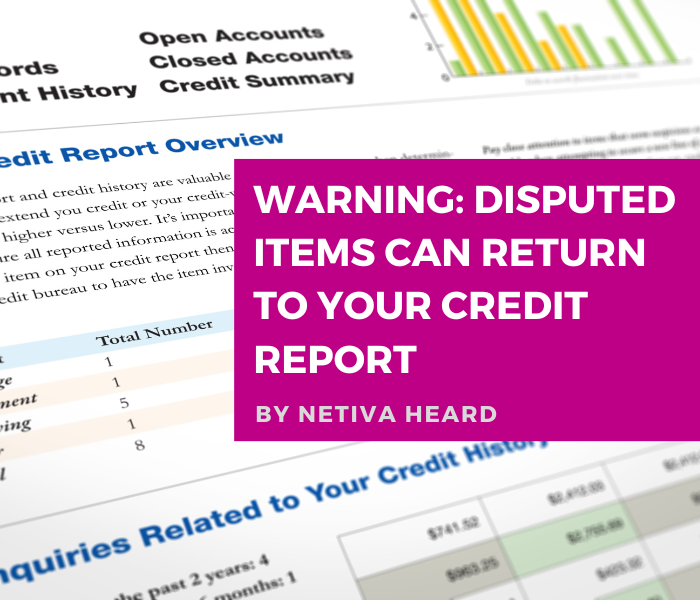One of the most common pieces of advice for protecting your credit score is to regularly review your credit report and look for inaccuracies. As many as one-third of Americans have errors on their credit reports. That’s only the beginning of the story, though.
Did you know disputed items and accounts can disappear and then reappear on your credit report? Let’s dig into why this happens and what you can do about it.
Why a Disputed Item Disappeared from Your Credit Report

If you review your credit report, find inaccurate information, dispute the inaccurate item, and see the item later disappear from your credit report, you would assume that the credit bureau investigated and found in your favor. In many cases, that isn’t what happened.
When you dispute an item to the credit bureau, they usually don’t truly investigate. They just contact the creditor and ask if the debt is accurate, and they take the creditor’s word for it. When the credit bureau reaches out, though, they give the creditor a deadline: usually 30 or 45 days. If the creditor doesn’t respond by the deadline, the credit bureau assumes the debt is unverifiable and removes it from your report.
Why an Item Can Reappear on Your Credit Report
If an item you disputed disappears from your credit report, don’t celebrate too soon. In fact, there are two reasons why it might reappear.
The Creditor Verified the Debt After the Deadline
As we mentioned, when the credit bureau asks a creditor to verify the item you disputed, they give them a deadline of 30 or 45 days. It isn’t a true deadline, though. If the creditor responds after that time and says the item is accurate, the credit bureau will put the disputed item back on your credit report. This is called a reinsertion and credit bureaus are required by law to notify you within five days if there is a reinsertion.
The Creditor Re-Aged Old Debt
This possibility is far shadier. Negative marks on your credit report have a certain statute of limitations: 7 years for most circumstances or 10 years for chapter 7 bankruptcies. After that time, the negative item must be removed.
Some creditors, though, will change the date on a debt and re-report it so it looks like it isn’t old enough to pass that statute of limitations. They do this in an effort to pressure you to pay the debt, but it is illegal because they are providing false information to the credit bureau.
What to Do if a Disputed Item Returns to Your Credit Report

If an item reappears on your credit report, there are steps you can take depending on the circumstances.
File a New Dispute
If there’s an item or account that you disputed, had removed, and now see on your credit report again, you can file a new dispute. This time, provide more supporting documentation to back up your dispute.
Filing a new dispute could encourage the credit bureau to do a true investigation rather than just taking the creditor for its word. The key, though, is adding new supporting documentation so your second dispute has new information. If you just re-file the same dispute, the credit bureau may dismiss your dispute as frivolous.
Make sure you file your dispute in writing and that you have a way to verify that they received it. For instance, send your dispute via email and request a return receipt.
Dispute the Item with the Creditor
Another strategy to use along with disputing the item with the credit bureau is disputing the item with the creditor directly. Send them a letter detailing your dispute and explaining why the debt is not valid. As with the dispute to the credit bureau, send your creditor dispute in writing and require a return receipt or another type of documentation that they received it.
Report Re-Aged Debt
If the reappearing item on your credit report is an old item that is actually past the statute of limitations and you suspect that the creditor changed the date, your course of action is different. You should report this to the Federal Trade Commission or FTC who should investigate the creditor for illegal business practices.
A Last Resort: Legal Action
If you’re in a situation where there are inaccurate items on your credit report and creditors are refusing to correct or remove them, especially if these items are having a significant impact on your credit, you may want to get an attorney and file a legal claim. The National Association of Consumer Advocates has a list of attorneys who specialize in these types of claims and lawsuits.
Keeping Your Credit Report Safe
From identity theft to genuine human error, there are many reasons you may have incorrect information on your credit report…and multiple reasons why information might reappear after you thought it was resolved. Follow the guide above to stand your ground and make sure your credit report is fair.
And if you’re still stumped about your credit report, my free course is made for you. Enroll in the free 5-Day Credit Report Mastery Challenge today!









